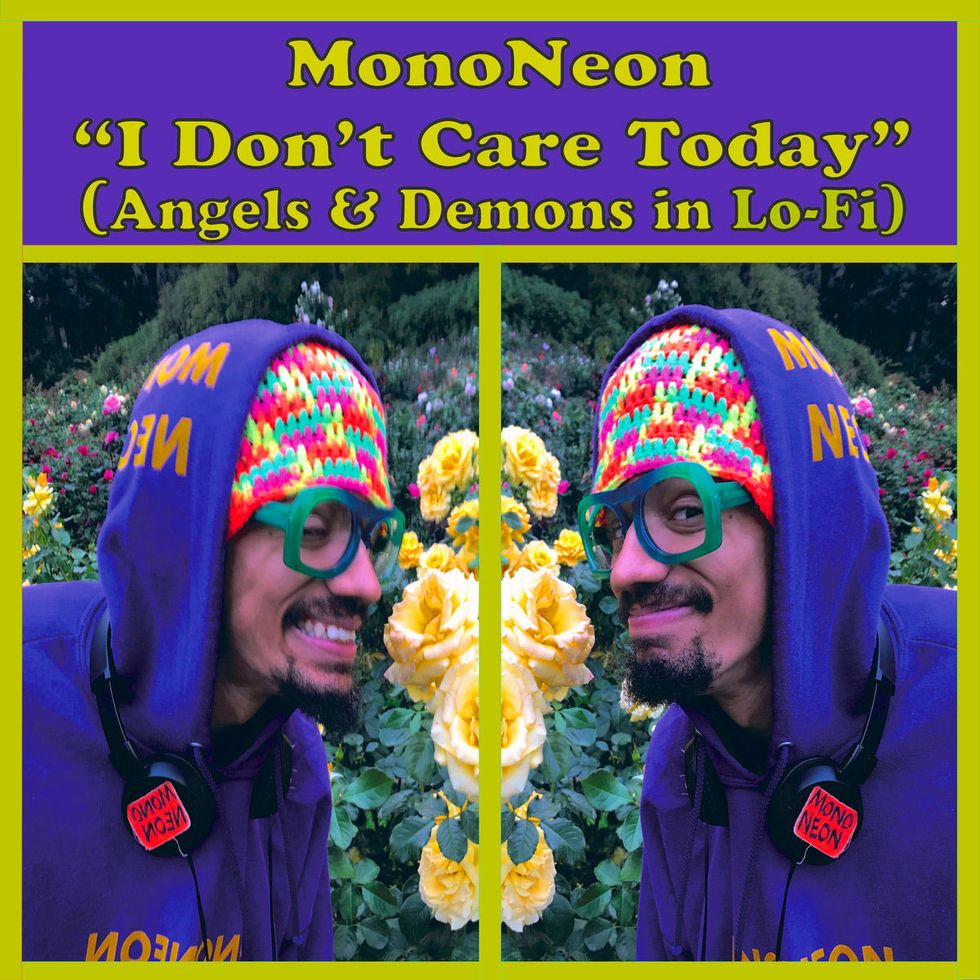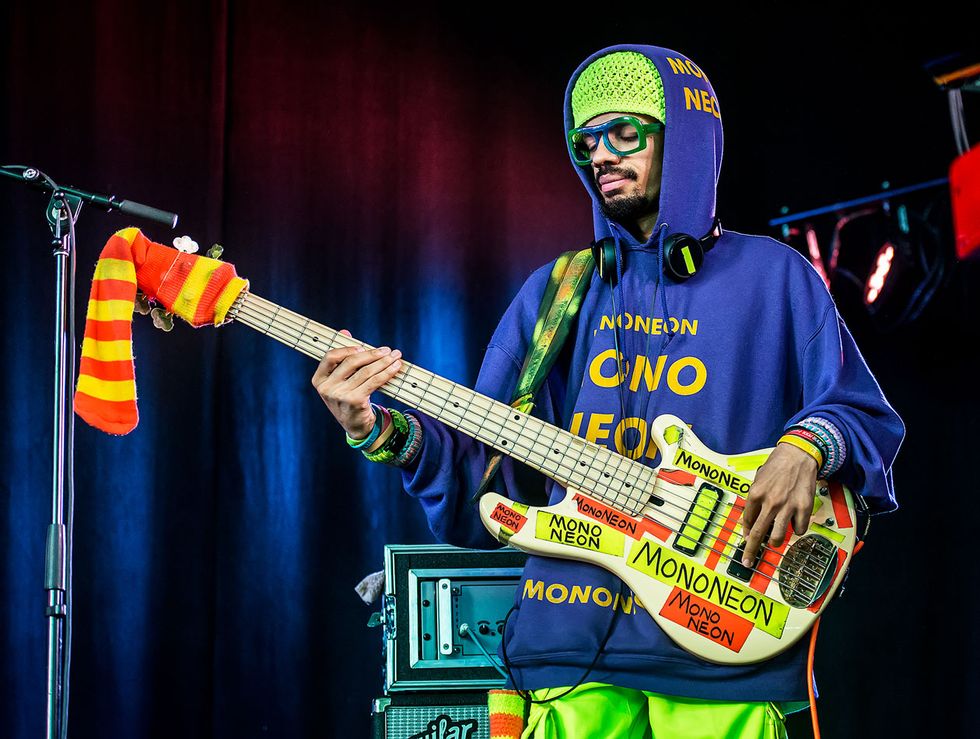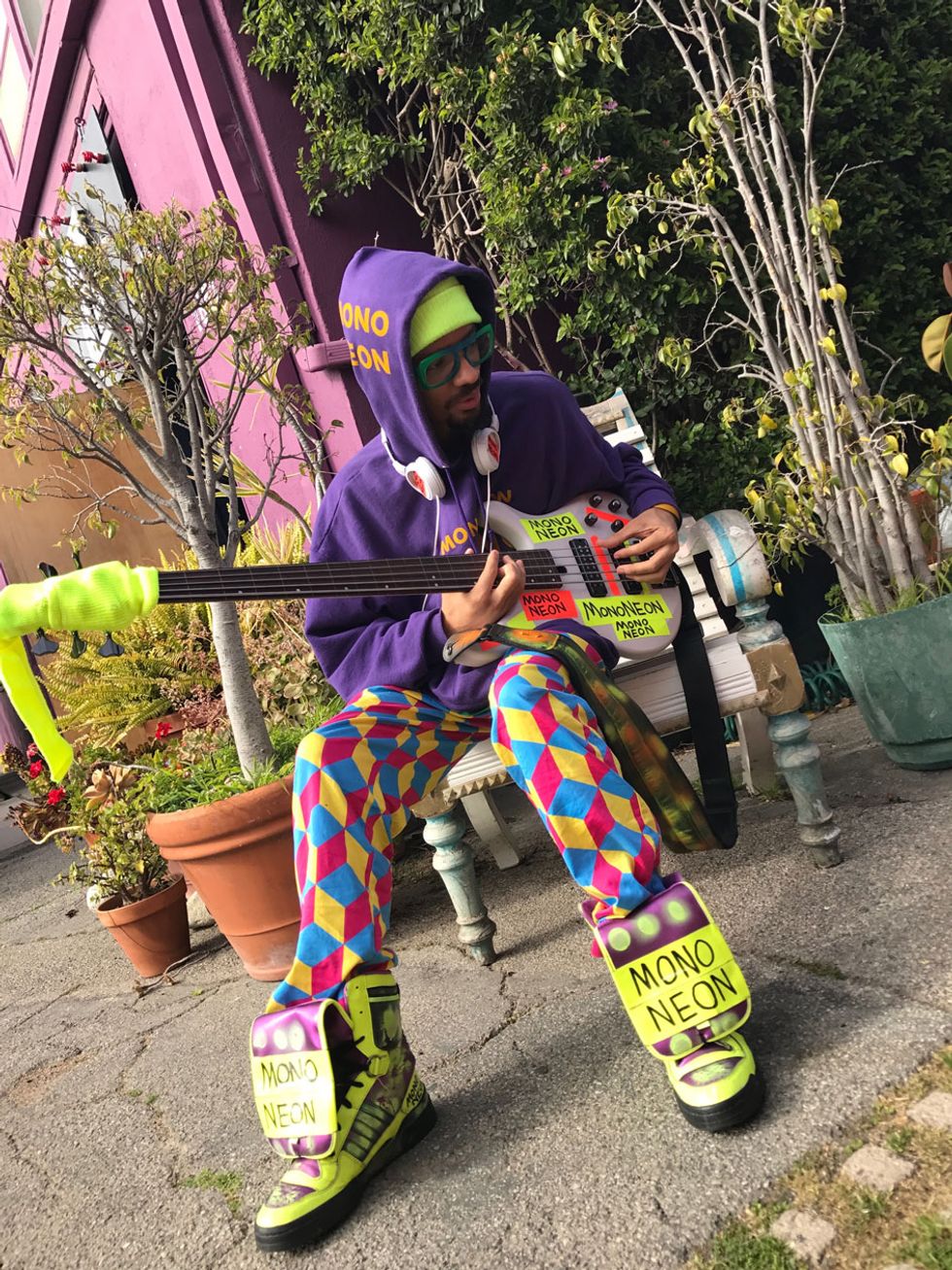In the early 1900s, French artist Marcel Duchamp pioneered a concept called readymade art. His works were based around mass-produced objects, as well as “improvements” to acknowledged masterpieces. For example, his piece Fountain is a urinal that he signed and displayed in a museum. Bicycle Wheel is a bicycle wheel mounted to a stool, and L.H.O.O.Q. is a postcard of the Mona Lisa, but modified with a mustache and goatee.
Duchamp’s work was controversial and became a catalyst for Dadaism, an “anti-art” movement born out of subversive artistic expressions in relation to political and cultural status quo. It made a huge impact on subsequent generations of creatives, one of them being our featured artist, Memphis-based bassist Dywane “MonoNeon” Thomas Jr.
Thomas, aka MonoNeon, enjoys exploring ideas within this avant-garde ethos. Duchamp’s readymade art is what inspired him to create his own musical persona, and his musical works are something of a YouTube sensation. On his YouTube channel, MonoNeon takes videos—many of which have already gone viral and usually feature a rant by someone famous like Cardi B, Will Smith, or Donald Trump—and he accompanies them word-for-word on bass. He then loops a selection or phrase, lays down a funky groove, and blows next-to-impossible riffs and fills over the top. He often wears ski goggles and is illuminated by fluorescent-colored clothing, bright wool hats, and an official MonoNeon hoodie. He also hangs a neon sock on his bass headstock, for good measure.
It’s YouTube. It’s odd. It’s ridiculous. And it catches your attention. More importantly, MonoNeon’s bass technique and chops are jaw-dropping. In early 2015, he caught the attention of the Purple One himself, Prince, who hired MonoNeon to work with Prince’s then-protégé Judith Hill, but Prince soon added MonoNeon to his own group as well. MonoNeon played sessions and jammed with Prince at Paisley Park—they recorded an album’s worth of material—but all that came to an end with Prince’s untimely death in 2016.
But the show must go on. MonoNeon keeps busy as a member of Ghost-Note, a band led by Snarky Puppy percussionists Nate Werth and Robert “Sput” Searight. He tours with steel drummer Jonathan Scales, and plays with the New Power Generation, a band of Prince alumni.
MonoNeon is a solo artist, too, and he releases a steady stream of lo-fi, irreverent, off-beat albums—most of which are available on Bandcamp—including his recent full-length album, I Don’t Care Today (Angels & Demons in Lo-Fi). His vision and aesthetic are articulated in his own “MonoNeon Art Manifesto,” which he displays at the end of every video (see image), and his idealism is inspiring. The last line reads: “Reject the worldly idea of becoming a great musician…JUST LIVE MUSIC!”
MonoNeon is a man of few words, but in our interview, he opened up about collaborations, low-budget recordings, gear, and his musical relationship with Prince.
When did you first start playing?
I started playing when I was 4 years old. I started with guitar, but I played it like a bass.
Did you take lessons?
No formal lessons. I listened to records and the radio. I learned songs from the radio. I think I was 10 or 12 when I played in my first band.
And then you went to Berklee?
Yeah. I went to Berklee for two years and then I left. That was from 2008 through 2010. I did study microtonal music with David Fiuczynski. I was in his Planet MicroJam and Mahavishnu ensembles.
Did you take private lessons with him, too?
Somewhat. It was more like a hang and I learned stuff. I played with Jack DeJohnette once because of Fiuczynski, too.

TIDBIT: MonoNeon is very prolific, constantly loading new content to his YouTube channel and releasing new music on Bandcamp. In 2018, he released an LP, I Don’t Care Today (Angels & Demons in Lo-Fi) LP, and several stand-alone tracks.
Talk about a few of your collaborations, like the work you’ve done with Eric Gales, Judith Hill, and Ghost-Note.
I really haven’t played with Eric Gales—that was just NAMM stuff. I recently opened for him a couple months ago, though. Prince hired me to be Judith Hill’s bass player in early 2015 and then I started playing with him in late 2015 until early 2016. I started playing with Ghost-Note after Prince passed. I’ve been with them ever since.
How do these projects work? Do they give you charts or is it more collaborative?
It is more collaboration or they send a demo of a new song and I learn it.
How did you hook up with Prince?
He found me online. He found out about me from my videos and one of his managers contacted me via email.
Did you record an album with him?
He released one song while he was here. It’s called “Ruff Enuff.” It’s like an instrumental jam thing. I’m not sure what’s going to happen with the other tracks. It was released under my name, but it was released on NPG Music.
Was he particular about gear and tone?
He was meticulous in general, but I don’t know if he was meticulous about gear. He just wanted things to sound good.
Did he give you pointers?
He just let me play. It depends. If he really wanted something particular, he would tell me, but in general, he would just let me play.
Did you jam a lot as well?
A lot, especially during rehearsals. Rehearsals usually turned into jams. But that’s what he wanted. He could do that all night.
What instruments would he play when you were jamming?
Either keys or guitar.
“I like to bend strings a lot, so that’s an advantage,” says MonoNeon of his upside-down, left-handed bass approach. He prefers 5-string Lakland basses. Photo by Fred SanFilipo
In your videos, you often play along to people speaking. Describe the process of transcribing and learning to play what people are saying.
I just repeat and repeat and repeat until I get it. I sit around and learn it. I don’t write anything out. It takes a lot of time to retain it, remember it, and get it under my fingers. It’s stuff that I just like to do: It’s cathartic for me to do it.
How do you put together your arrangements?
During the process. I don’t think about it before, but when I’m doing it, I think about it.
Do you find that people have a natural cadence when they speak that lends itself musically?
Yeah. Especially, for some reason, Cardi B really works for me.
What is it about her speech that works for you?
I don’t know, I just hear a lot of melodicism in it. I don’t know what it is. It just works.
Does that hold true for Angry Grandpa and Donald Trump as well?
Somewhat. I like Will Smith. I do some of his videos, too.
What gear are you using to create those videos?
I plug into an interface. I have a one-channel interface, the Apogee Jam. I plug my guitar into it, unplug it, and then plug my bass into it. I also use the Apollo Twin Solo if I’m home recording stuff.
Besides Prince, have other people been in touch with you because of your videos?
A few people. I can’t remember who else found me, but I get emails and messages a lot from people because of my videos.
Are you right-handed or left-handed?
I am right-handed.
What made you decide to start playing left-handed?
I’ve been playing that way since I was 4 years old and I never changed.
Do you find there are advantages to playing that way?
I like to bend strings a lot, so that’s an advantage. It’s easier to bend because the higher strings are on top.
What’s your approach to slap?
It’s really the same way everybody else does it. I slap with my thumb and I pop with my fingers. It’s just upside down.
Playing upside down doesn’t make it more challenging?
I just pluck. I really don’t think deep about this. I just do it.

Basses and Guitars
Lakland Skyline 55-01
Fender Jazz bass (fretless)
Yamaha TRBX505 (fretless)
Yamaha Revstar
Amps
TC Electronic Blacksmith
TC Electronic and EBS cabs
Effects
Apogee Jam
Universal Audio Apollo Twin Solo
DigiTech Whammy Pedal
TC Electronic Helix Phaser
TC Electronic SpectraComp Bass Compressor
Danelectro Fab Tone
Strings and Picks
Dunlop Super Bright Nickel 5-String Bass Strings (.045–.125)
Medium-gauge picks (guitar)
Any other techniques?
I palm-mute a lot. I don’t work on my tapping a lot. I’m really standard when it comes to technique.
Do any of these things transfer to guitar playing?
Rhythm guitar playing. I’m not much of a lead soloist, I’m more of a rhythm guitar player.
Do you use a pick for guitar?
Yep.
How did you develop your sense of groove? Did you spend time with a metronome?
I really just play to records, that’s all.
Do you use a click when recording your albums?
I really don’t. I don’t really record to a BPM [beats per minute]. If I do, I have to remind myself to do it, but I usually don’t.
Are there things you recommend others do to develop a sense of time?
Play to records, that’s the best way for me. Playing to a metronome is cool, but playing to records is more fun, I guess.
Did you do things to develop your speed as well?
I’m not really fast. I just repeat and repeat stuff until I get it.
How did you develop your harmonic sense? Have you transcribed jazz solos?
When I was young, I tried to do that stuff, but I never really stuck with it. I never sat around and transcribed Bird or Jaco. I just took fragments from what they did and played around with it. I never transcribed a whole solo.
Did you study harmony? Did you take theory classes at Berklee and learn about substitutions and chord scales and things like that?
Yeah, but I really don’t use it. Everything is intuitive. Like, everything I do is intuitive.
Meaning you hear something and play what’s in your head.
Yep. Sometimes it doesn’t work. Sometimes I fall on my face doing it, but it is what it is.
You studied microtones with Fiuczynski. Do you still work with those?
I haven’t recently, but sometimes I mess around with quarter-tones. It’s still there, but I haven’t composed with it much.
You go for a lo-fi sound on your solo releases. Do you use that same aesthetic when working with other people?
I’m sure it comes out somewhere unintentionally. My love for lo-fi came from not knowing what the hell I am doing. So, I just fell in love with it. It’s nostalgic. I just like it.
Do you go direct when recording with others as well?
Yep.
Bassist MonoNeon’s colorful aesthetic was inspired by the subversive Dada artistic movement pioneered by French artist Marcel Duchamp.
Are you particular about a direct box or any type of gear?
Not really, as long as it’s warm and not cold. I like my sound to be warm. I don’t like recording with headphones. I would be in the studio with Prince and he wanted me in the control room with him to record because he knew that playing with headphones would get silly.
How would it make you silly?
You get really silly with the headphones. I really can’t feel the bass with headphones on.
Would Prince have you play with an amp as well?
No. I can’t remember what he plugged me in to. It was some type of preamp. I wish I had paid attention to that.
What type of bass is your 5-string?
It’s a Lakland. I think I bought it off Reverb, my current one. I bought my Vintage Creme Lakland when I was playing with Prince at Paisley Park in 2015. There are some clips on Prince’s Instagram with me playing that bass at one of the “Paisley Park After Dark” shows.
Do you experiment with tunings?
Really standard. I haven’t really messed with any other tunings. The low string is tuned to B.
Tell us about your quarter-tone bass.
That bass was built by the builder Tim Cloonan for CallowHill Guitars. Tim is no longer with us. He built that bass in 2014, I think. I told him to do whatever he wants with it. I just wanted a quarter-tone bass, that’s all. I think it is 35" scale length.
Do you play fretless, too?
That’s where I started on the microtonal stuff, on fretless. I have a Fender and a Yamaha fretless.
Did you take the frets off?
On my Fender I did, it was a fretted Fender. It’s a Jazz-style bass, and it’s passive. I got someone to take the frets out.
What guitars do you have?
I have a Yamaha—I think it is called a Revstar—and an old Peavey that I don’t play much. My preferred guitar is the Yamaha.
What do you use for pedals? I’ve seen you with the DigiTech Whammy.
That’s my primary pedal. I just like it. I really started using it because of Prince. I’ve always had one, but when I started to play with him, I started using it a lot.
He encouraged it?
It was always on the pedalboard and he really liked that pedal. He used it in a very cool way. It influenced me being around him.
How so, like when you use it to jump into another register?
Yes.
That’s it?
I have a TC Electronic phaser that I use sometimes.
No fuzz?
If I do use fuzz, it’s the Danelectro fuzz pedal, which I got from Prince, too.
What about an amp and cabs?
I’m really open about that. I like TC Electronic cabinets. They don’t break up for some reason. I also use EBS cabinets.
What about a head?
The TC Electronic Blacksmith or anything with a lot of headroom.
Do you own a head or do you just use whatever’s there when you tour?
Sometimes I send in a rider for a particular amp. I give them options. It can be an EBS or TC Electronic or Aguilar. But if I don’t get that, I’m really straight, as long as it sounds good and is not distorting.
Like an old SVT wouldn't do it for you?
Well sometimes. I played an Ampeg recently with NPG and it was cool.
What was your composing process for I Don’t Care Today (Angels & Demons in Lo-Fi)?
Cardi B was a muse for the album. Some of the grooves came from the songs I created from Cardi B’s rants—at the end of the videos—the grooves came from that. Those songs are just written from moments I was in. I already knew what type of album I wanted to create. I finished it pretty fast. Some of the artists I found on the internet. Like the first song, “I Don’t Care Today,” is this girl, she posted Instagram stories. She was singing that, “I don’t care …” She’s from Japan and I found it and I put it on the album. So, it was just random stuff like that that inspired the album.
Do you sing on it as well?
Yeah, I sing on the majority of the stuff on the album. I just don’t sing in public. I’m not ready yet.
How about the drums?
I got Daru Jones from the Jack White band. I got Amber Baker; she’s the drummer from Unknown Mortal Orchestra. But most of the drums are sequenced—just played on a keyboard—on a MacBook Pro.
You did it right on the computer?
I don’t have a MIDI controller. I usually play the drums on the keypad on my computer.
You lay down the bass first and then play the drums over that?
Yeah or the other way around. I create a pattern and then I loop it.
And the guitars and bass are done through the Apogee?
Yeah. But for some tracks I use my Universal Audio plug-in stuff. I have the Apogee Twin interface and I use some of the mastering plug-ins for my album, too.
You do everything yourself, even all the mastering?
Yeah, I guess you could call it that. It’s just really trial and error, because I hate waiting for people to do my stuff. If I had patience, my album probably would sound better. A lot of my stuff probably would sound better, if I had patience to let people master and mix my stuff. But yeah, I do everything.
After a slow intro, Thomas starts cooking at 1:46 in this clip during a set with Jonathan Scales Fourchestra in 2016.
Watch MonoNeon display his rapid-fire bass technique and incredible groove while playing with Ghost-Note in Los Angeles in June 2018.














![Rig Rundown: Russian Circles’ Mike Sullivan [2025]](https://www.premierguitar.com/media-library/youtube.jpg?id=62303631&width=1245&height=700&quality=70&coordinates=0%2C0%2C0%2C0)












![Rig Rundown: AFI [2025]](https://www.premierguitar.com/media-library/youtube.jpg?id=62064741&width=1245&height=700&quality=70&coordinates=0%2C0%2C0%2C0)




















 Zach loves his Sovtek Mig 60 head, which he plays through a cab he built himself at a pipe-organ shop in Denver. Every glue joint is lined with thin leather for maximum air tightness, and it’s stocked with Celestion G12M Greenback speakers.
Zach loves his Sovtek Mig 60 head, which he plays through a cab he built himself at a pipe-organ shop in Denver. Every glue joint is lined with thin leather for maximum air tightness, and it’s stocked with Celestion G12M Greenback speakers.











